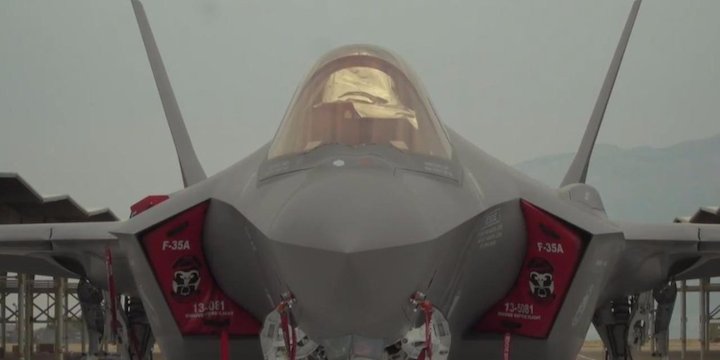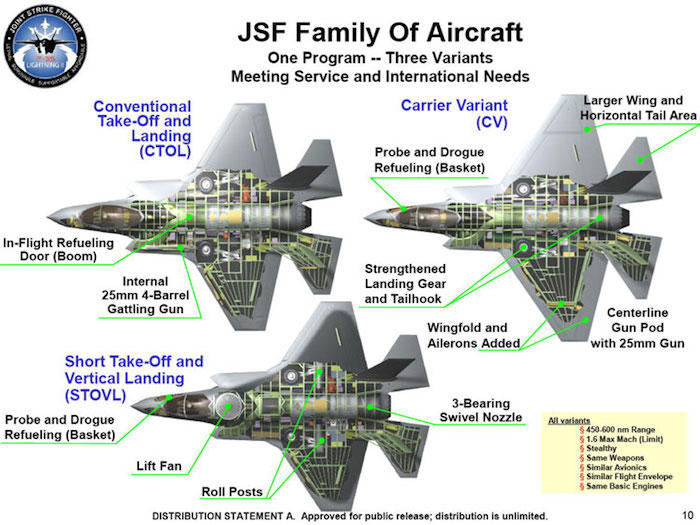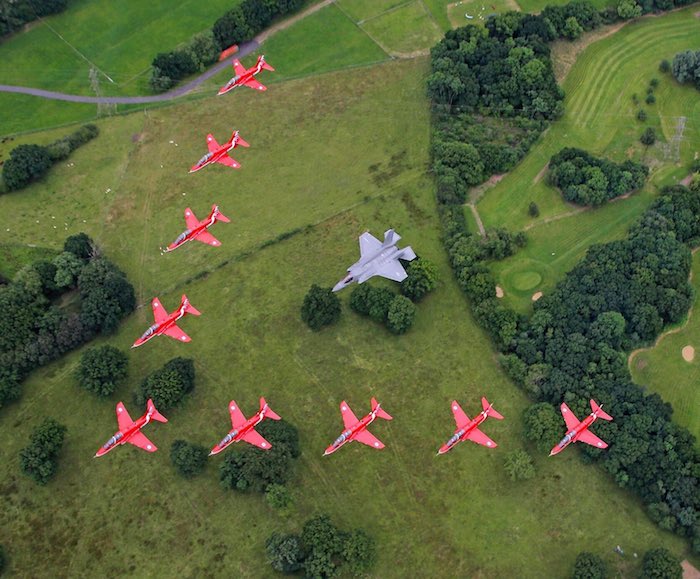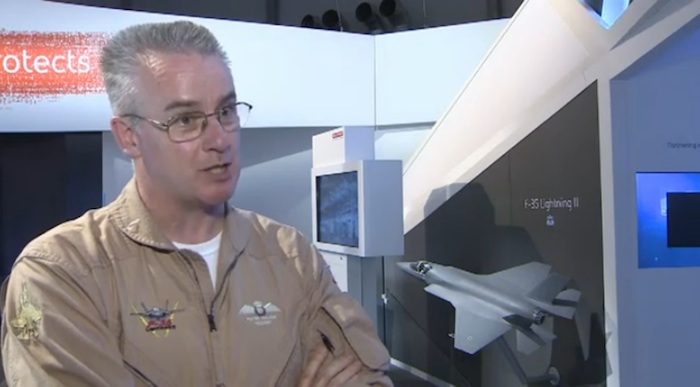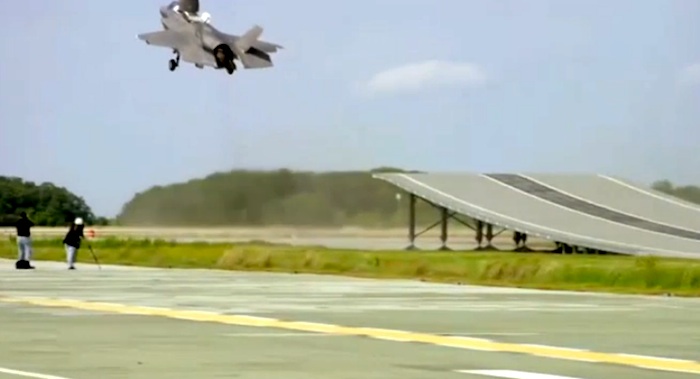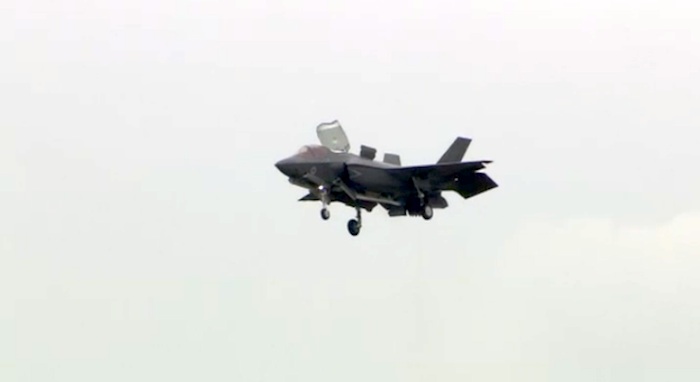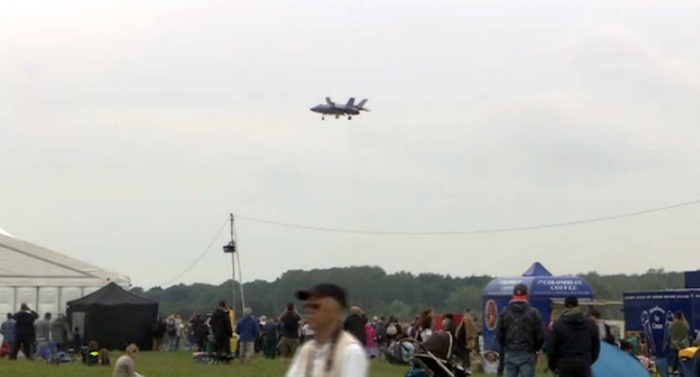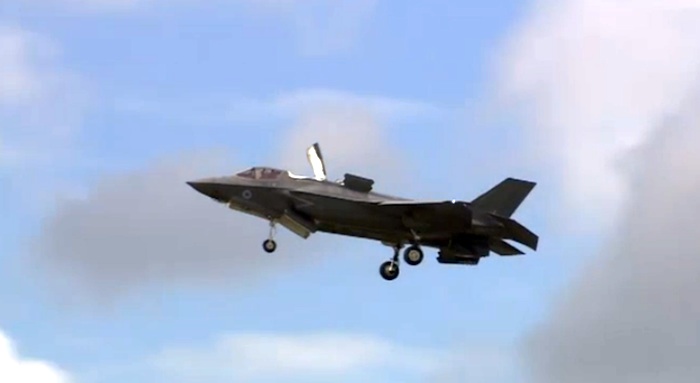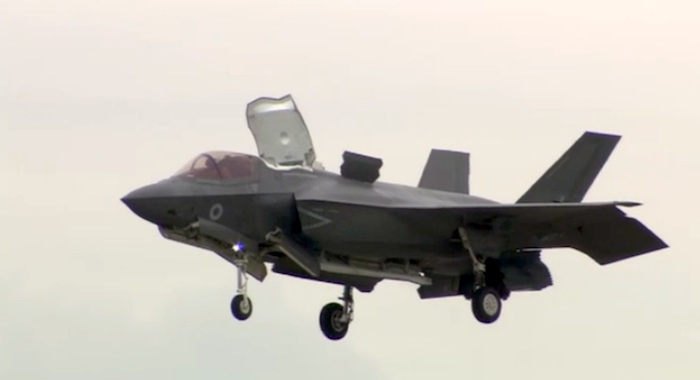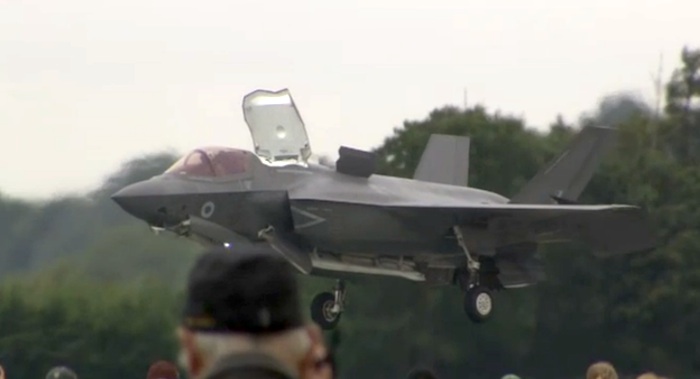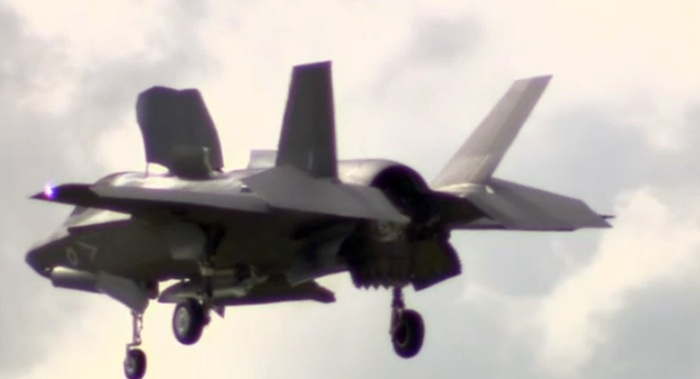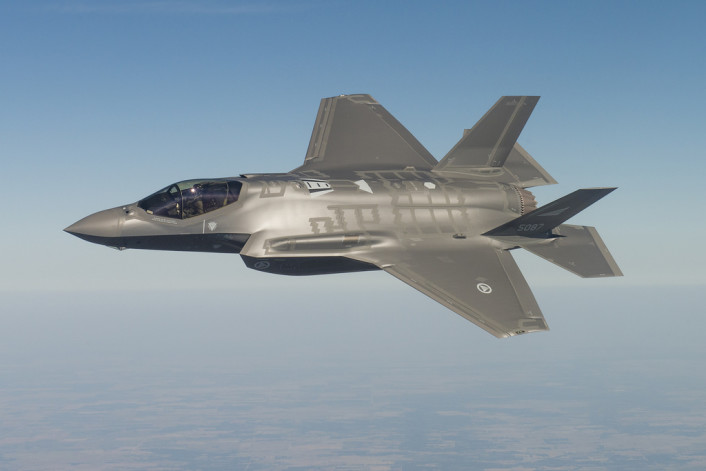The Ministry of Defence have clarified the details surrounding the Queen Elizabeth class aircraft carriers and their complement of F-35 aircraft, no doubt in response to the plethora of claims that the vessels will sail with “no aircraft”, “no crew”, no sandwiches in the galley etc.
.
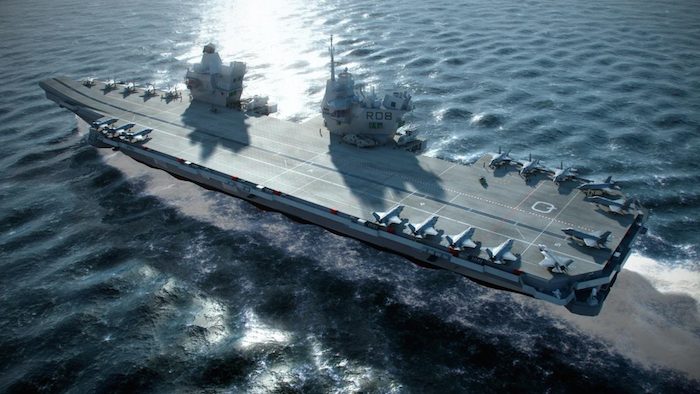
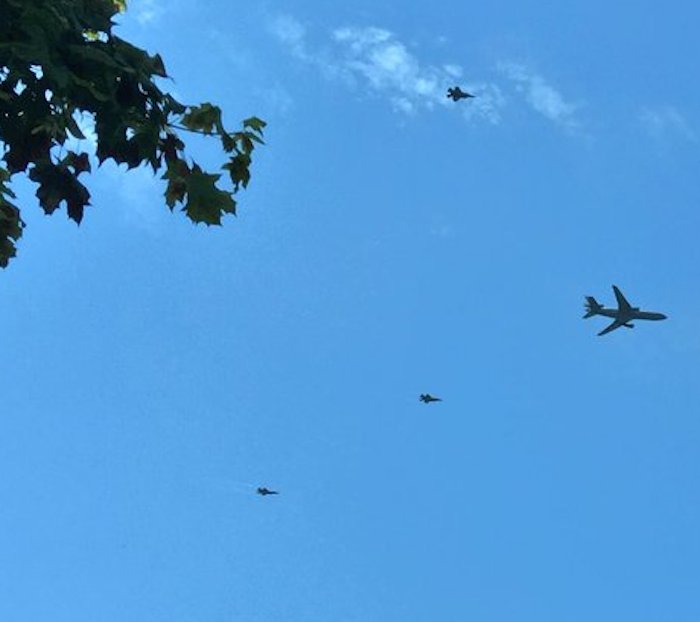
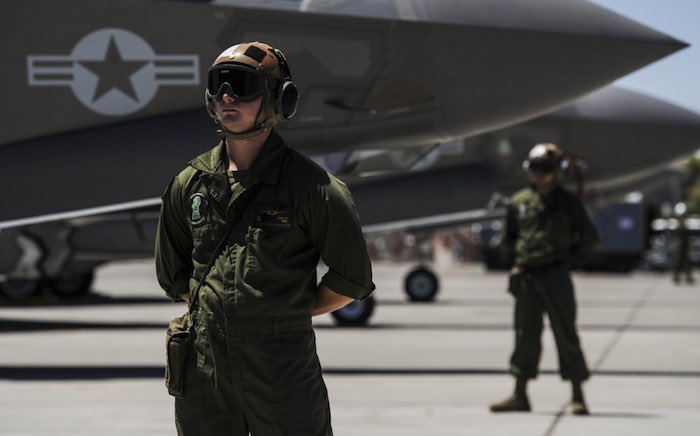
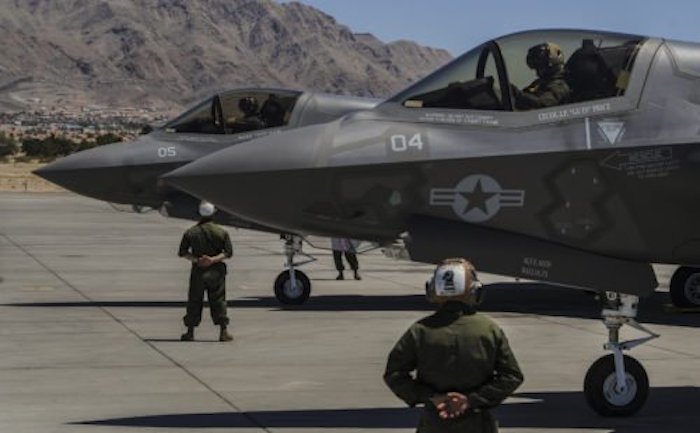
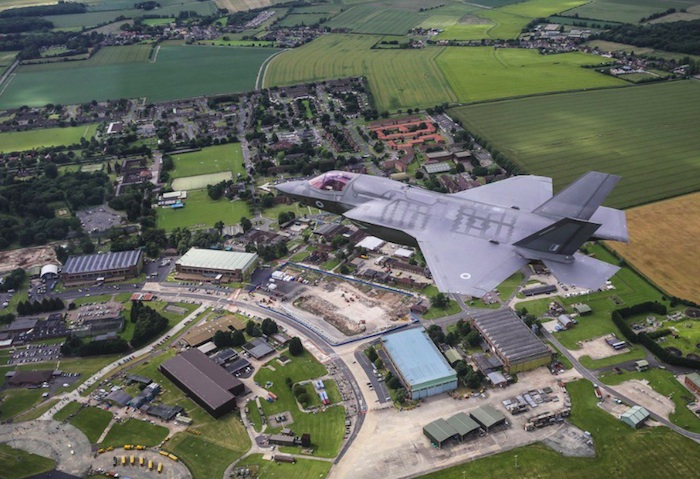
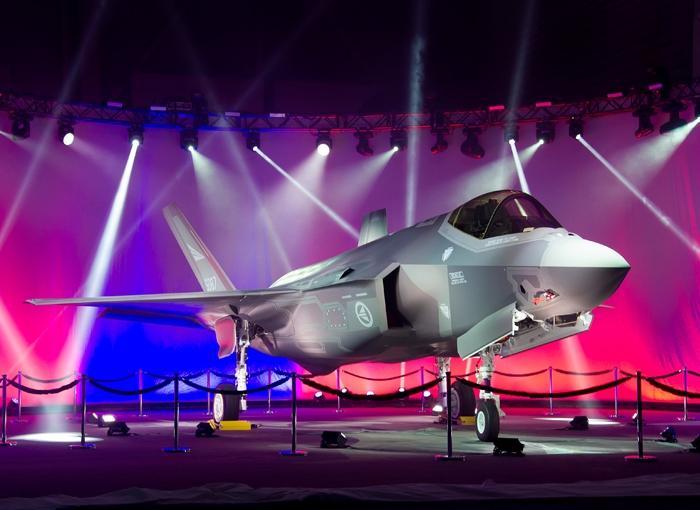
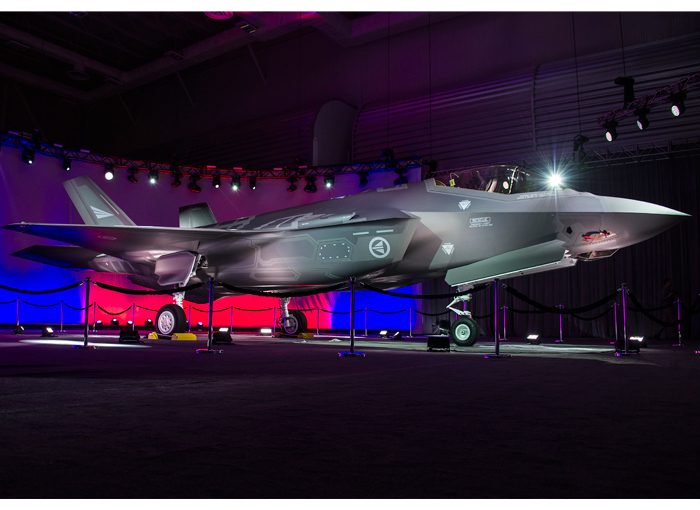
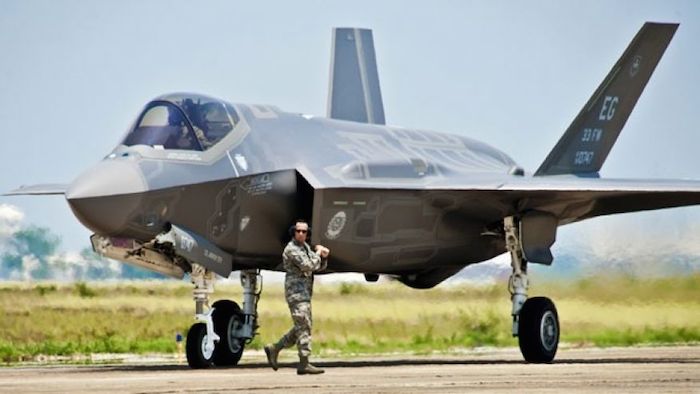 -
-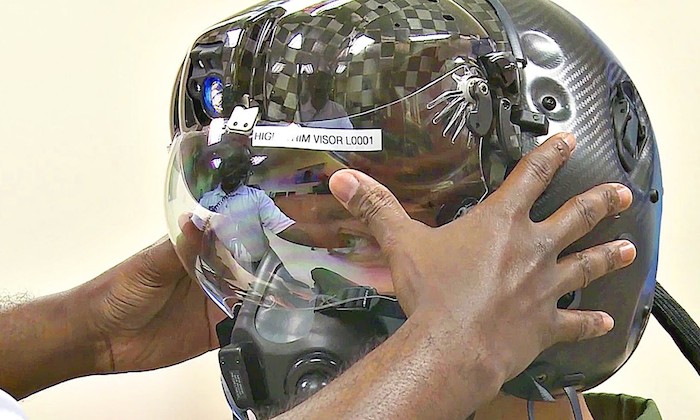

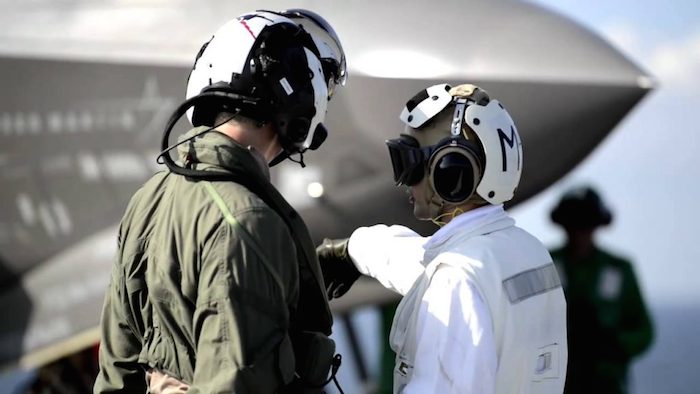

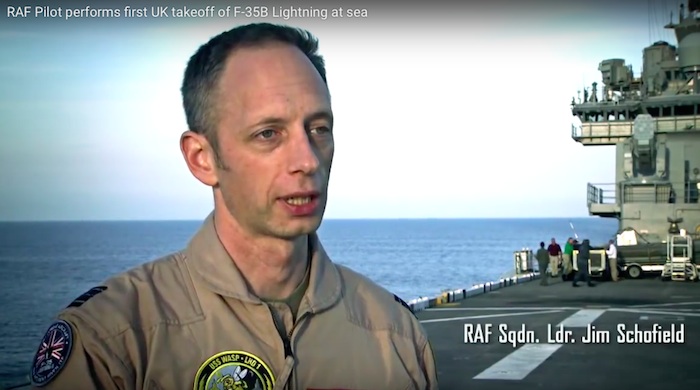

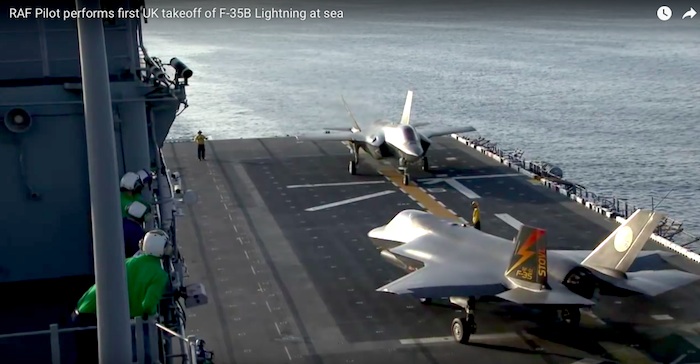
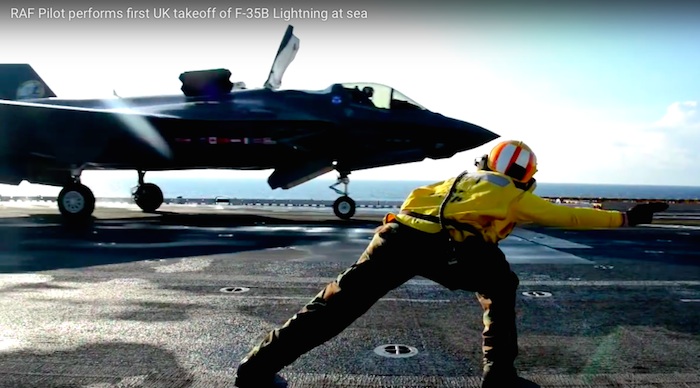
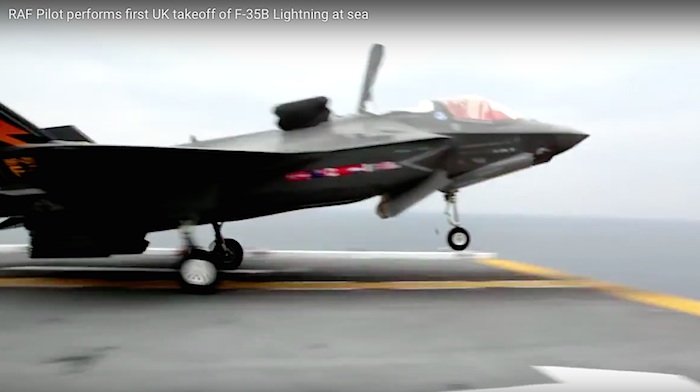
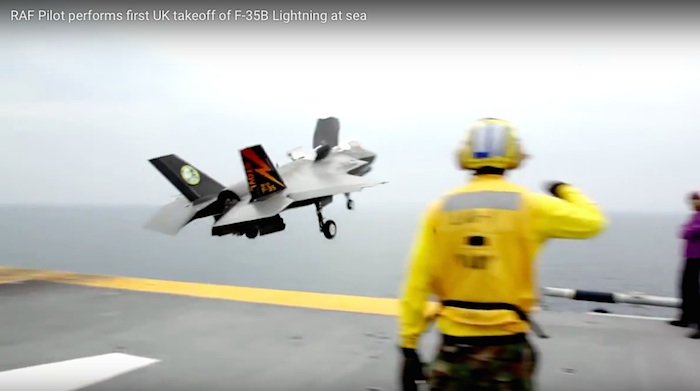
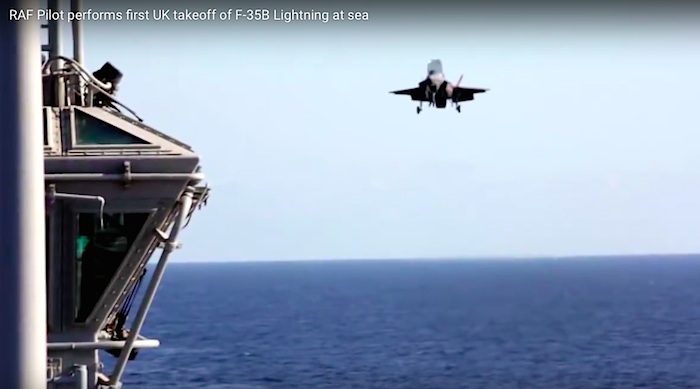
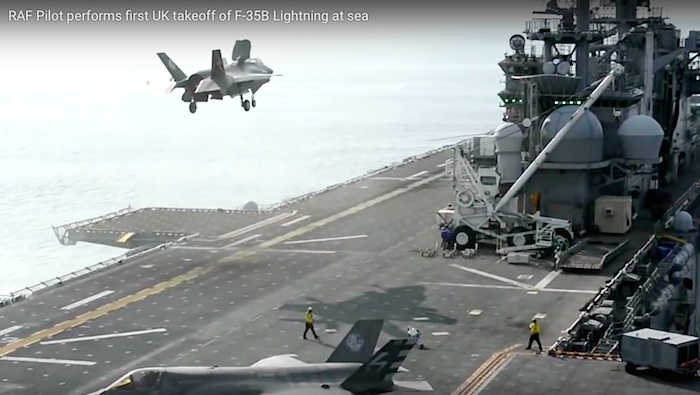
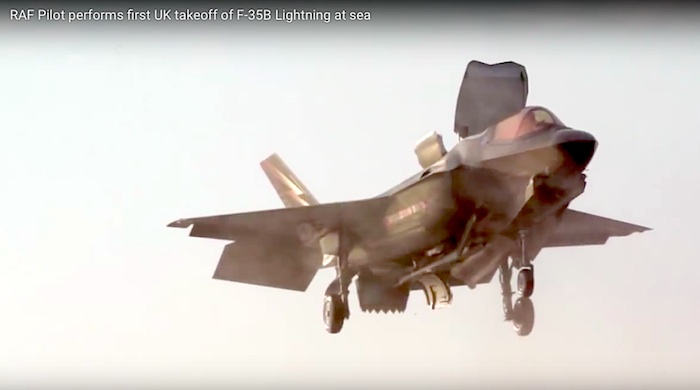


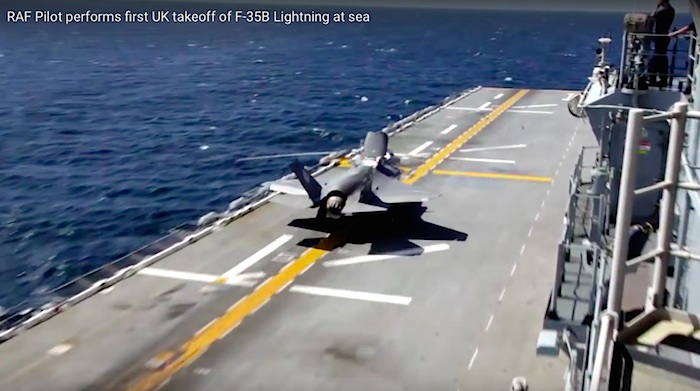
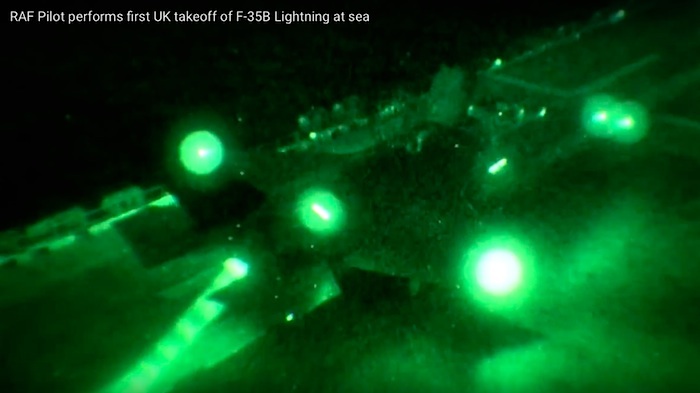
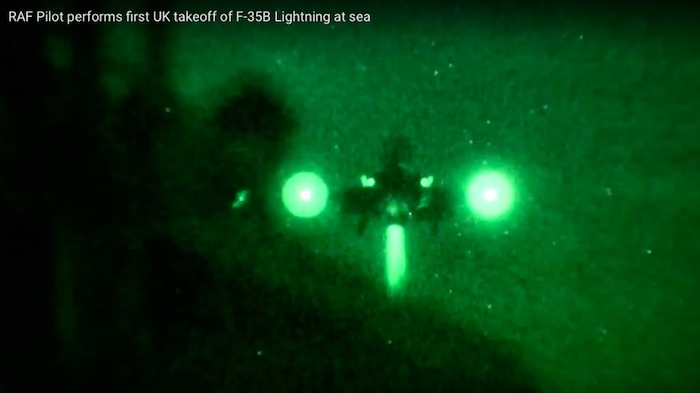
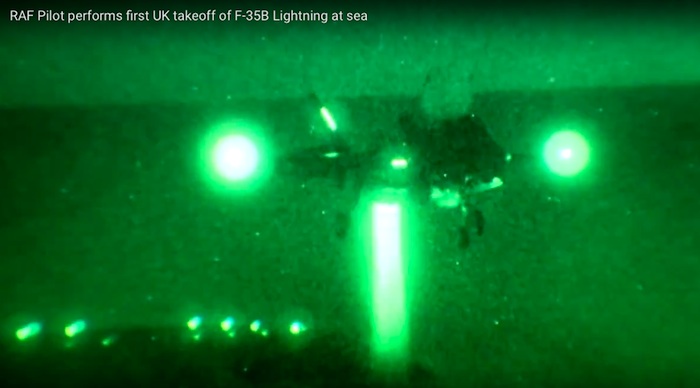
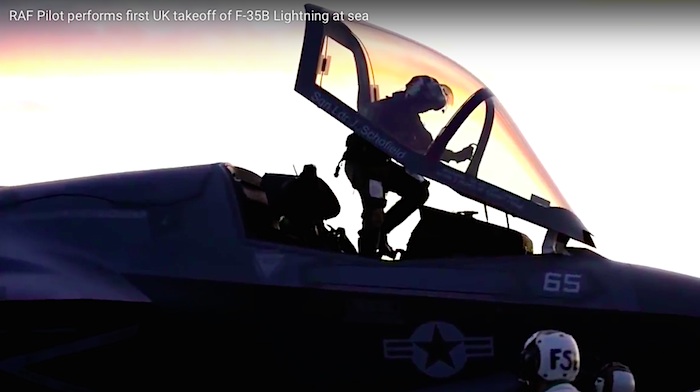
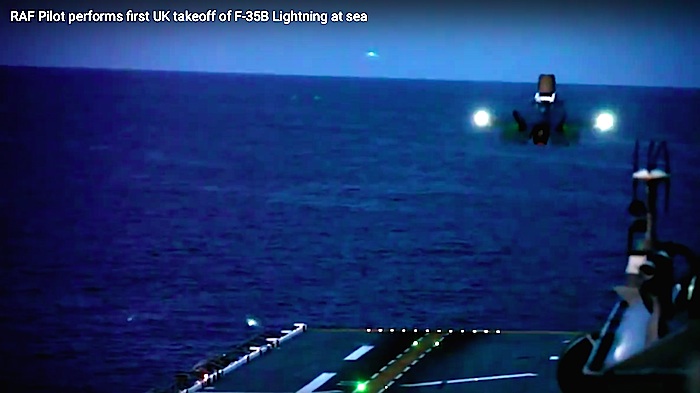
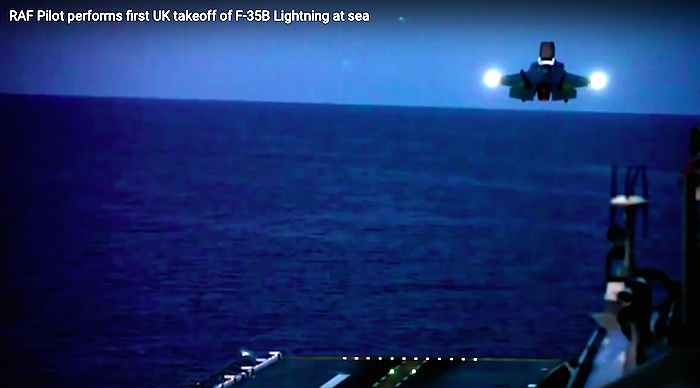
Frams: RAF-Video
-
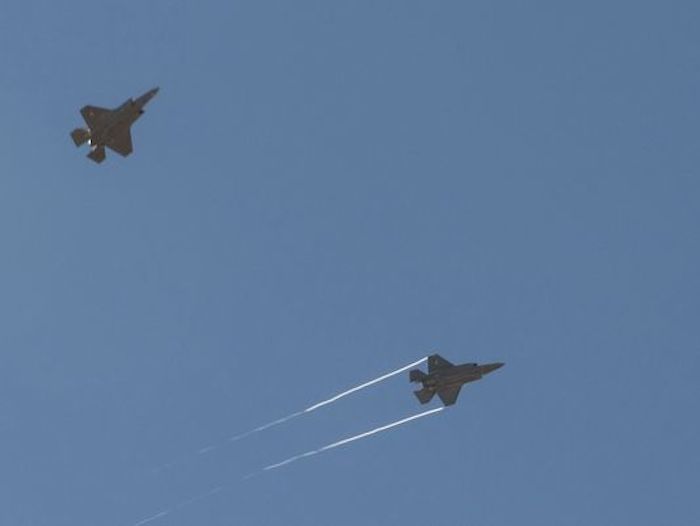
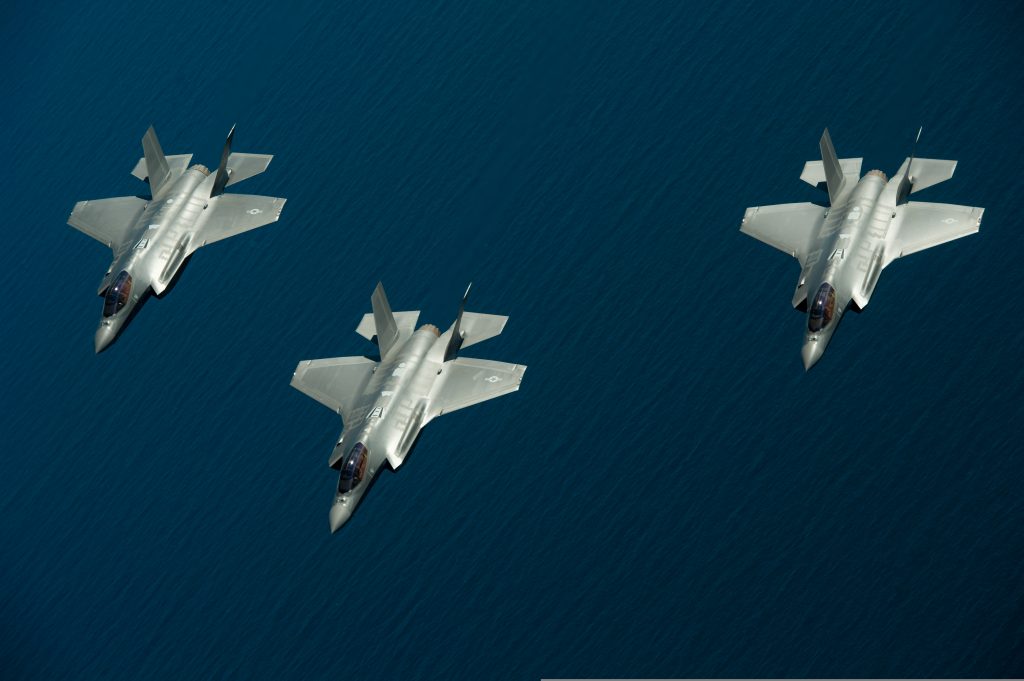
F-35s pound F-15s in mock dogfights -
-
Update: 31.07.2016
.
Britische und amerikanische Einheiten einheitlich bei der F-35B Ausbildung
In 2018, the UK’s first F-35B squadron will declare initial operational capability, we take a look at how they’ll get there.
It is understood that in order to train to meet operational requirements, a decision was made many years ago to integrate the training of the USMC and RAF together. About 10 years ago the UK’s Royal Air Force and Royal Navy began discussions about combining efforts on initial F-35B training with the United States Marine Corps.
Air Cdre Harv Smyth said:
“It started out as just a conversation about, ‘Wouldn’t it be a good idea to pool our resources? In the early years, we knew we’d both have a small number of jets and a small number of people training, so it just made sense to work together.”
These discussions eventually resulted in a ‘pooling implementation agreement’ between the RAF, Royal Navy and USMC.
The Royal Air Force and Royal Navy plan to operate 138 F-35B aircraft. Their training will take place at MCAS Beaufort, South Carolina, where British pilots and maintainers will be embedded with the U.S. Marine Corps and their fleet of F-35Bs. In February 2015, the RAF 17 Squadron, which is responsible for the operational test and evaluation of the UK’s first F-35s, was formally stood up at Edwards AFB, California.
Smyth claims British forces wouldn’t be able to reach that 2018 IOC goal without the partnership with the Marine Corps.
“The Marines at Beaufort have been phenomenally welcoming and accepting of us. Even when we have a conflict every once and again, we always find a way to work to a great solution that works well for both sides. We would not be having the success we’re having there if it weren’t for this partnership.”
Sqn Ldr Hugh Nichols said:
“It’s essentially three services melded together to form one unit at Beaufort, on any given day, you could have an RAF pilot hoping in a USMC jet with a Royal Navy maintainer there with the jet. Or a Marine hoping in a UK je or any combination, really.”
According to the US Marine Corps in a press release:
“The PIA has turned out to be a win-win for the Marine Corps and UK services. For one thing, they get to share knowledge and lessons learned when it comes to flying and maintaining the jets. In addition, sharing jets allows the both sides to be able to train more pilots, and quicker.
Of course eventually, the UK forces will make their way back in-country for training on their home soil. By early 2018, Sqn Ldr Nichol’s 617 Squadron will be formally stood up. Later that year, the first of the UK aircraft will ferry over to RAF Marham and then work towards IOC in December 2018.”
The F-35 features a significant amount of British developed components, in addition to 15% of every jet sold globally being built in Britain.
As the only Level 1 partner, the United Kingdom has garnered tremendous economic benefits from the F-35. British industry will build 15% of each of the more than 3,000 planned F-35s, in addition to a large volume of British developed aircraft systems including the electronic warfare suite.
The programme at peak will generate significant export revenue and GDP growth. The programme is projected to create and support more than 24,000 jobs across every region of the United Kingdom.
...
Update: 8.08.2016
.
Will the F-35 feature laser weapons?
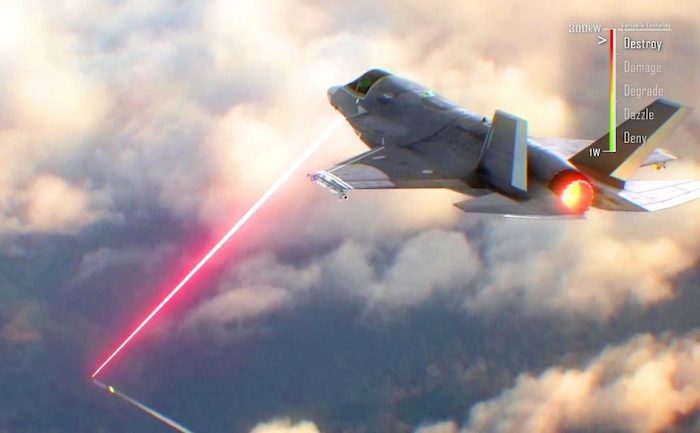
Lockheed Martin is considering laser weapon concepts for use by the F-35 and other aircraft.
A recent press briefing in the Netherlands for the F-35 has restarted the rumour mill that the F-35 will be one of the platforms that will eventually feature laser based weapons technology.
The US military and its allies have allocated millions of dollars for directed energy research and development. The US Air Force is pursing laser weapon systems for installation on fighter jets as well as the AC-130J Ghostrider gunship.
The UK also recently announced its interest in creating a directed energy based defence system, similar to Phalanx, for its warships.
Lockheed Martin, Notre Dame University, DARPA and the Air Force Research Lab last year started flight testing a streamlined and miniaturised airborne laser turret.
The turret allows for 360 degree aiming coverage for directed energy weapons that will be flying on military aircraft in the not so distant future and is able to rapidly aim at targets and focus a directed energy burst through the atmosphere at those targets to disable or destroy them.
Lockheed senior fellow for laser and sensor systems said at a media briefing on the 5th of October last year:
“We’re looking at concepts for the integration of a laser weapon onto the F-35. We’re also looking at the utility and doing models and calculations so you would understand the utility of a leaser weapon system in the F-35.”
General Ellen Pawlikowski, commander of Air Force Materiel Command, said recently that the US Air Force is continuing efforts to field directed energy weapons:
“I think we’re on the cusp of actually being able to field a true laser weapon within the next five to six years. We’ve got an activity that’s going forward, to put a laser on a fighter aircraft, not to blow up scud missiles or to win in a dogfight, but as an air defence.”
Rumours and speculation are rife but at a time where directed energy based technology is fast being adopted by the military, we can only expect them to become more common.
Quelle: UK Defence Journal @UKDefJournal
-
Update: 12.09.2016
.
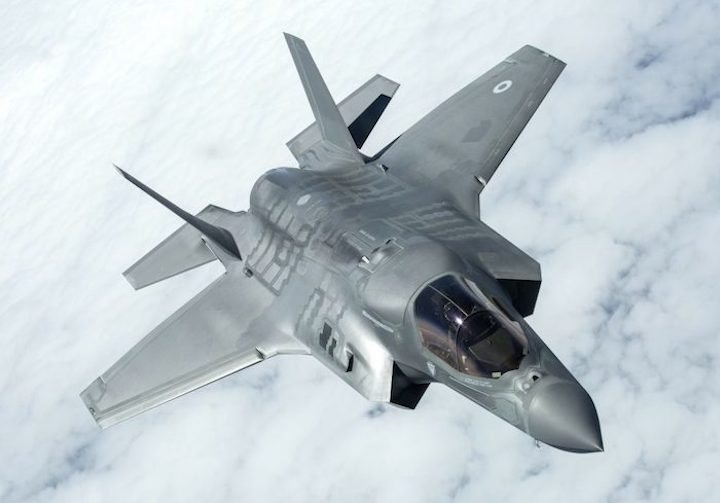

---
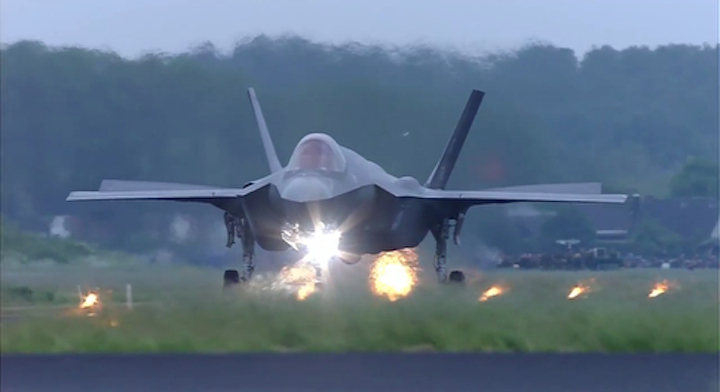
In den Niederlanden sind die ersten neuen Jagdflugzeuge vom Typ F-35 aus den USA angekommen. Ohne auf die Frage einzugehen, ob sich dieser Joint Strike Fighter, überhaupt ein Kampfflugzeug dieser Art für das Land rechnet, ein Hinweis anderer Art: Die Ankunft hat das niederländische Verteidigungsministerium im Stil einer Live-Übertragung via YouTube begleitet.
---
“Here’s what I’ve learned so far dogfighting in the F-35”: a JSF pilot’s first-hand account

A Norwegian pilot shared his experience flying mock aerial combat with the F-35.
As we reported last year, the debate between F-35 supporters and critics became more harsh in July 2015, when War Is Boring got their hands on a brief according to which the JSF was outclassed by a two-seat F-16D Block 40 (one of the aircraft the U.S. Air Force intends to replace with the Lightning II) in mock aerial combat.
Although we debunked some theories about the alleged capabilities of all the F-35 variants to match or considerably exceed the maneuvering performance of some of the most famous fourth-generation fighter, and explained that there is probably no way a JSF will ever match a Eurofighter Typhoon in aerial combat, we also highlighted that the simulateddogfight mentioned in the unclassified report obtained by WIB involved one of the very first test aircraft that lacked some cool and useful features.
Kampflybloggen (The Combat Aircraft Blog), the official blog of the Norwegian F-35 Program Office within the Norwegian Ministry of Defence, has just published an interesting article, that we repost here below under permission, written by Major Morten “Dolby” Hanche, one of the Royal Norwegian Air Force experienced pilots and the first to fly the F-35.
“Dolby” has more than 2200 hours in the F-16, he is a U.S. Navy Test Pilot School graduate, and currently serves as an instructor and as the Assistant Weapons Officer with the 62nd Fighter Squadron at Luke Air Force Base in Arizona.
He provides a first-hand account of what dogfighting in the F-35 looks like to a pilot who has a significant experience with the F-16. His conclusions are worth a read.
Enjoy.
The F-35 in a dogfight – what have I learned so far?
I now have several sorties behind me in the F-35 where the mission has been to train within visual range combat one-on-one, or «Basic Fighter Maneuvers» (BFM). In a previous post I wrote about aerial combat in general (English version available), and about the likelihood that the F-35 would ever end up in such a situation. In this post, however, I write more specifically about my experiences with the F-35 when it does end up in a dogfight. Again, I use the F-16 as my reference. As an F-35-user I still have a lot to learn, but I am left with several impressions. For now my conclusion is that this is an airplane that allows me to be more forward and aggressive than I could ever be in an F-16.
I’ll start by talking a little about how we train BFM. This particular situation – a dogfight one-on-one between two airplanes – may be more or less likely to occur, as I have described in a previous blog post (Norwegian only). Nonetheless, this kind of training is always important, because it builds fundamental pilot skills. In this kind of training we usually start out from defined parameters, with clearly offensive, defensive or neutral roles. This kind of disciplined approach to the basic parameters is important, because it makes it easier to extract learning in retrospect – a methodical approach to train for air combat.
A typical training setup begins at a distance of one, two or three kilometers from the attacker to the defender. The minimum distance is 300 meters. That kind of restriction may seem conservative, but 300 meters disappears quickly in a combat aircraft. Starting at different distances allows us to vary the focus of each engagement. Greater distance means more energy, higher g-loads and often ends in a prolonged engagement. A short distance usually means that the main objective is to practice gun engagements, either attacking or defending.
Before the training begins, we always check whether we are “fit for fight”; will I be able to withstand the g-load today? «G-awareness exercise» implies two relatively tight turns, with gradually increasing g-load. My experience is that especially dehydration, but also lack of sleep affects g-tolerance negatively. If someone has a «bad g-day», we adjust the exercises accordingly and avoid high g-loads.
As the offensive part, the training objective is to exploit every opportunity to kill your opponent with all available weapons – both missiles and guns – while maneuvering towards a stable position behind the opponent. From this «control position» it is possible to effectively employ both missiles and the gun, without the opponent being able to evade or return fire.
So how does the F-35 behave in a dogfight? The offensive role feels somewhat different from what I am used to with the F-16. In the F-16, I had to be more patient than in the F-35, before pointing my nose at my opponent to employ weapons; pointing my nose and employing, before being safely established in the control position, would often lead to a role reversal, where the offensive became the defensive part.

Classic maneuvering towards the control position with an F-16 (blue arrow); the offensive aircraft moves to reduce the difference in angle, and to end up behind its opponent.

The offensive (blue arrow) choses a too aggressive approach, and ends up being neutralized by its opponent.
The F-35 provides me as a pilot greater authority to point the nose of the airplane where I desire. (The F-35 is capable of significantly higher Angle of Attack (AOA) than the F-16. Angle of Attack describes the angle between the longitudinal axis of the plane – where nose is pointing – and where the aircraft is actually heading – the vector). This improved ability to point at my opponent enables me to deliver weapons earlier than I am used to with the F-16, it forces my opponent to react even more defensively, and it gives me the ability to reduce the airspeed quicker than in the F-16.
Update: Since I first wrote this post, I have flown additional sorties where I tried an even more aggressive approach to the control position – more aggressive than I thought possible. It worked just fine. The F-35 sticks on like glue, and it is very difficult for the defender to escape.

Maneuvering towards the control position with an F-35 (blue arrow) the offensive party can allow a greater difference in angle (more on the side than behind, and still remain established in the control position.
It may be difficult to understand why a fighter should be able to «brake» quickly. In the offensive role, this becomes important whenever I point my nose at an opponent who turns towards me. This results in a rapidly decreasing distance between our two airplanes. Being able to slow down quicker provides me the opportunity to maintain my nose pointed towards my opponent longer, thus allowing more opportunities to employ weapons, before the distance decreases so much that a role reversal takes place.
To sum it up, my experience so far is that the F-35 makes it easier for me to maintain the offensive role, and it provides me more opportunities to effectively employ weapons at my opponent.
In the defensive role the same characteristics are valuable. I can «whip» the airplane around in a reactive maneuver while slowing down. The F-35 can actually slow down quicker than you´d be able to emergency brake your car. This is important because my opponent has to react to me «stopping, or risk ending up in a role-reversal where he flies past me. (Same principle as many would have seen in Top Gun; «hit the brakes, and he’ll fly right by.» But me quoting Top Gun does not make the movie a documentary).
Defensive situations often result in high AOA and low airspeeds. At high AOA the F-16 reacts slowly when I move the stick sideways to roll the airplane. The best comparison I can think of is being at the helm of ship (without me really knowing what I am talking about – I’m not a sailor). Yet another quality of the F-35 becomes evident in this flight regime; using the rudder pedals I can command the nose of the airplane from side to side. The F-35 reacts quicker to my pedal inputs than the F-16 would at its maximum AOA (the F-16 would actually be out of control at this AOA). This gives me an alternate way of pointing the airplane where I need it to, in order to threaten an opponent. This «pedal turn» yields an impressive turn rate, even at low airspeeds. In a defensive situation, the «pedal turn» provides me the ability to rapidly neutralize a situation, or perhaps even reverse the roles entirely.
The overall experience of flying the F-35 in aerial combat is different from what I’m used to with the F-16. One obvious difference is that the F-35 shakes quite a bit at high g-loadings and at high angles of attack, while the F-16 hardly shakes at all. The professional terminology is «buffeting», which I also described in an earlier blog post (English version available).This buffeting serves as useful feedback, but it can also be a disadvantage. Because the buffeting only begins at moderate angles of attack, it provides me an intuitive feel for how much I am demanding from the aircraft; what is happening to my overall energy state? On the other hand, several pilots have had trouble reading the information which is displayed on the helmet visor, due to the buffeting. Most of the pilots here at Luke fly with the second-generation helmet. I fly with the third-generation helmet, and I have not found this to be a real issue.
What I initially found to a bit negative in visual combat was the cockpit view, which wasn’t as good as in the F-16. The cockpit view from the F-16 was good – better than in any other fighter I have flown. I could turn around and look at the opposite wingtip; turn to the right, look over the «back» of the airplane and see the left wingtip. That´s not quite possible in the F-35, because the headrest blocks some of the view. Therefore, I was a bit frustrated during my first few BFM-sorties. However, It turned out that practice was all it took to improve the situation. Now I compensate by moving forward in the seat and leaning slightly sideways, before turning my head and looking backwards. In this way I can look around the sides of the seat. I also use my hands to brace against the cockpit glass and the canopy frame. With regards to cockpit view alone, I had an advantage in the F-16, but I am still able to maintain visual contact with my opponent during aggressive maneuvering in the F-35. The cockpit view is not a limitation with regards to being effective in visual combat, and it would be a misunderstanding to present this as a genuine problem with the F-35.
On the positive side I would like to highlight how the F-35 feels in the air. I am impressed with the stability and predictability of the airplane. Particularly at high AOA and low airspeeds. It is a peculiar feeling to be flying the F-35 at high AOA. I can pull the nose up to where my feet «sit» on the horizon and still maintain level altitude. I’m also impressed by how quickly the F-35 accelerates when I reduce the AOA. High AOA produces lots of lift, but also tremendous induced drag. When I «break» the AOA, it is evident that the F-35 has a powerful engine. The F-35 also makes a particular sound at this point. When I quickly reduce the AOA – stick full forward – I can hear clearly, even inside the «cockpit» how the F-35 howls! It seems like the «howling» is a mix of airflow over the wings and a different kind of noise from the engine. Maybe this isn’t all that relevant, but I still think it´s a funny observation. Another aspect is the kind of reaction I get when I push the stick forward; the F-35 reacts immediately, and not delayed like the F-16. Looking at another F-35 doing such maneuvers is an impressive sight. The various control surfaces on the airplane are large, and they move very quickly. I can monitor these movements on the screens in my cockpit, and I´m fascinated by how the control surfaces move when I manipulate the stick and pedals. Especially at high AOA, it is not always intuitive what control surfaces move, and by how much.
Quelle: THE AVIATIONIST
-
Update: 1.11.2016
.

F-35 Norge
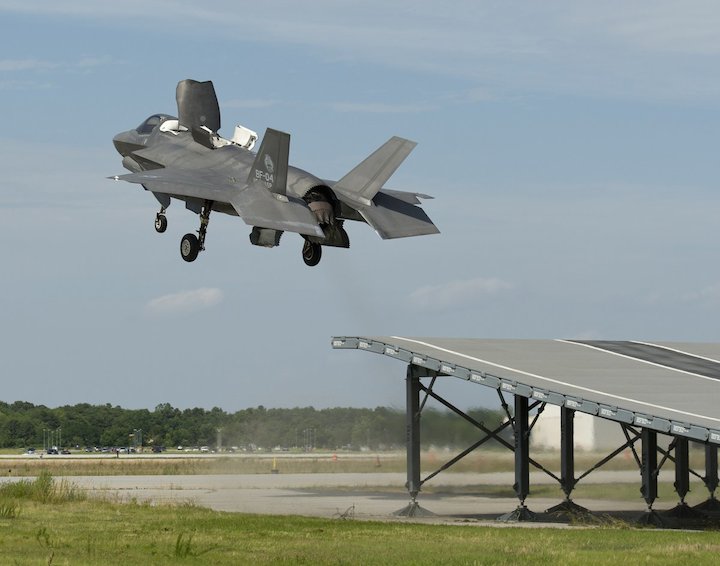
F-35 RAF
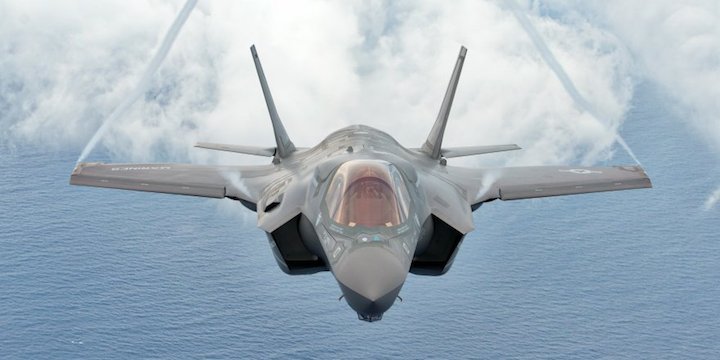
F-35 RAF
...
Update: 2.11.2016
.
Lockheed-Martin stellt beste Fotografien von F-35B bei Trainingsflügen vor:

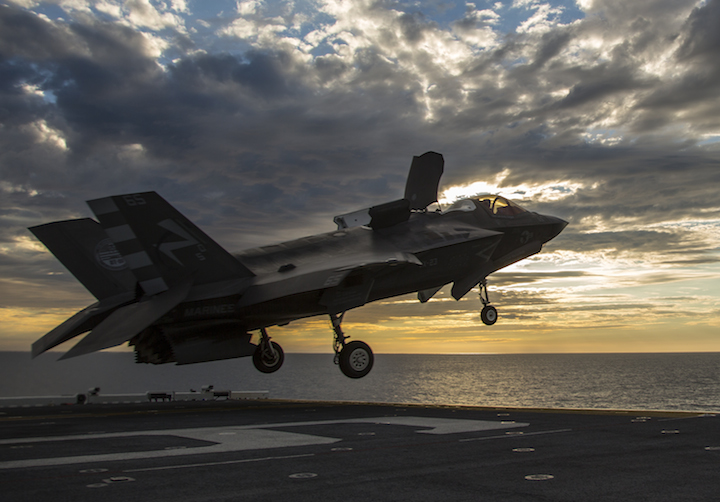
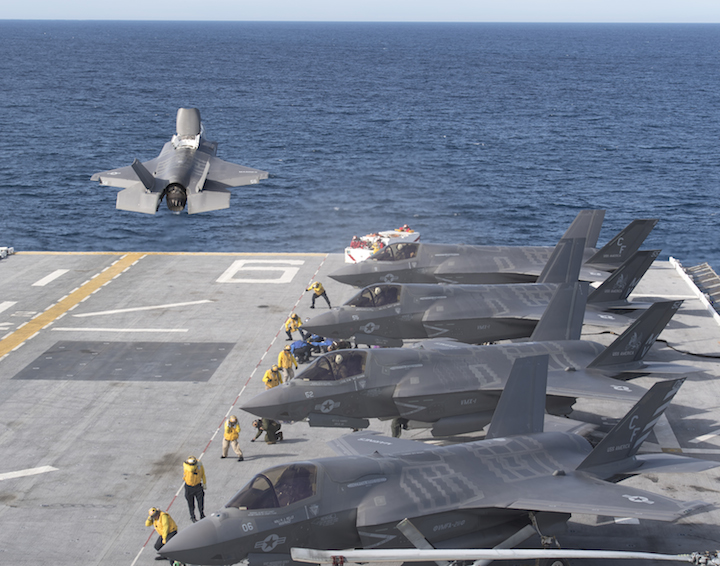
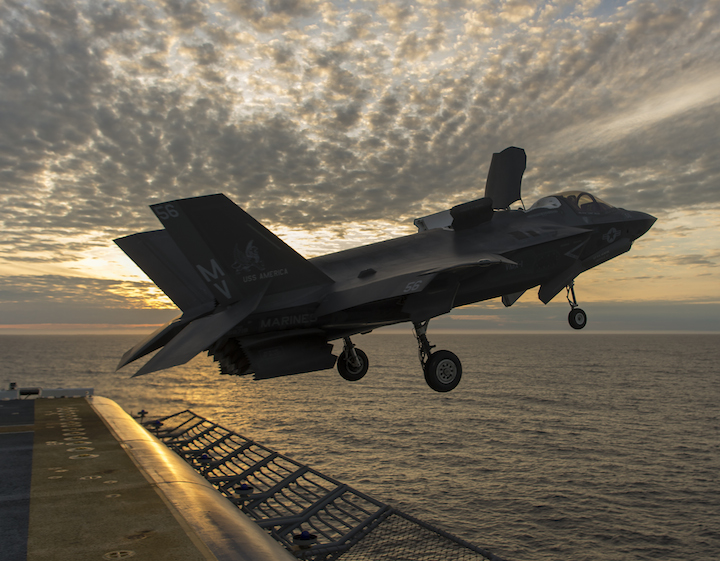
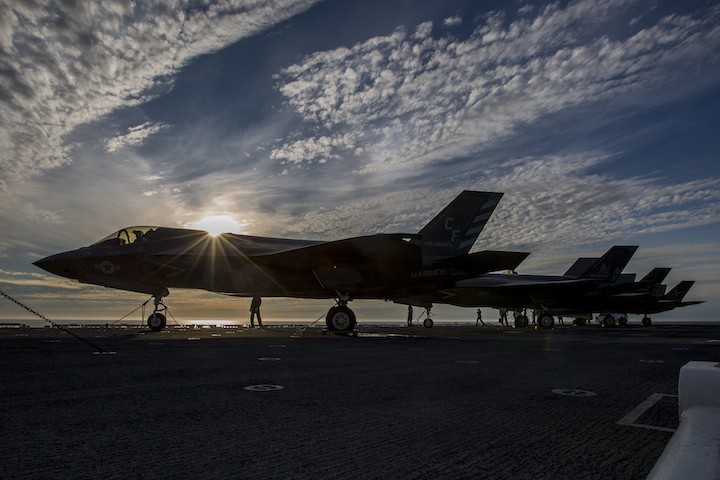
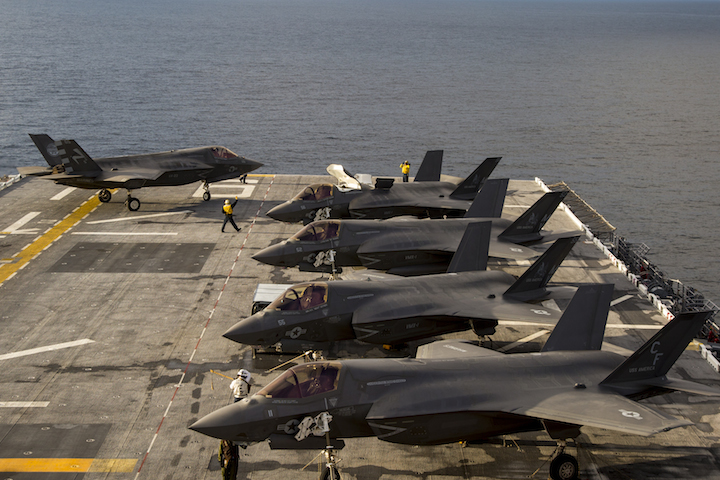
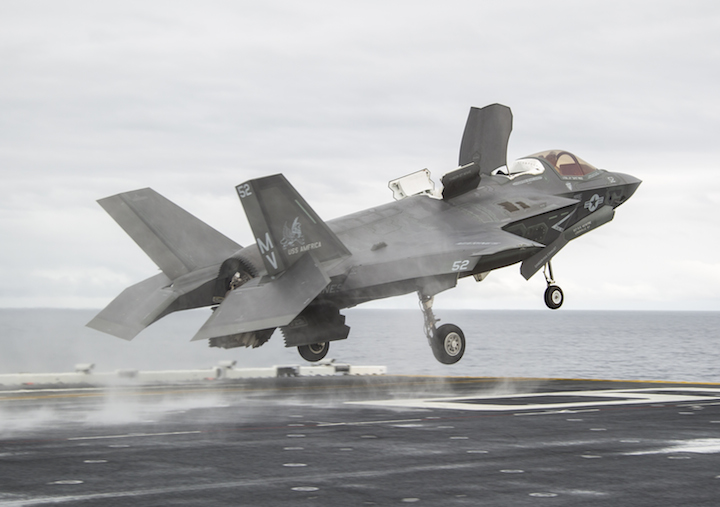
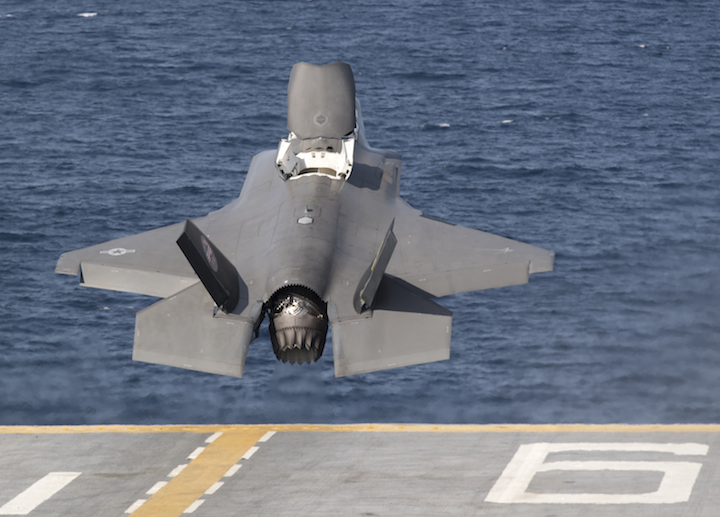
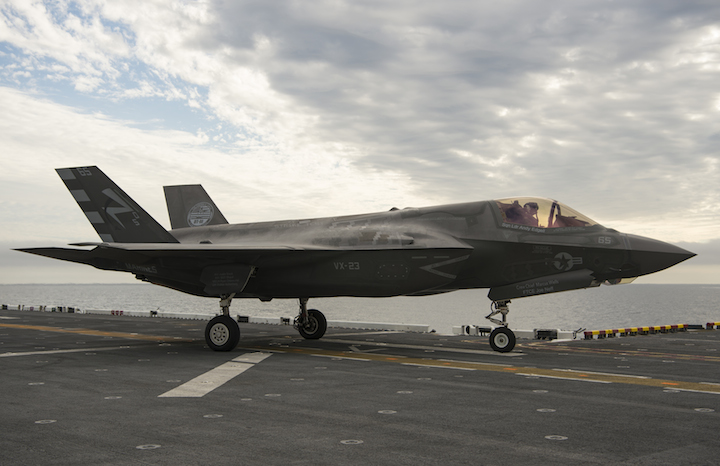
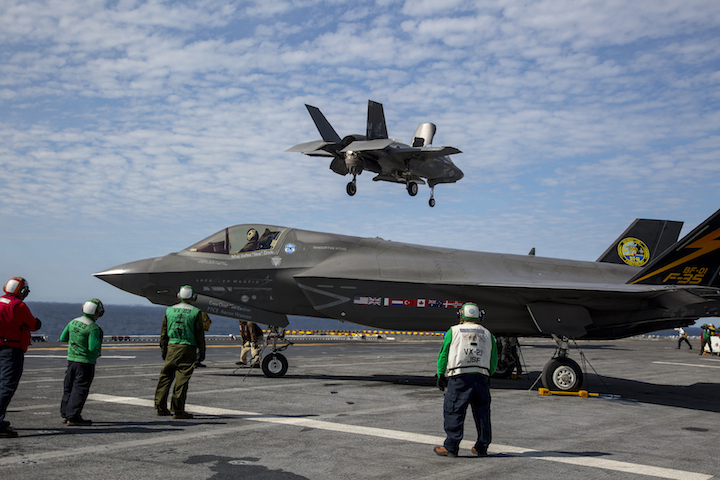
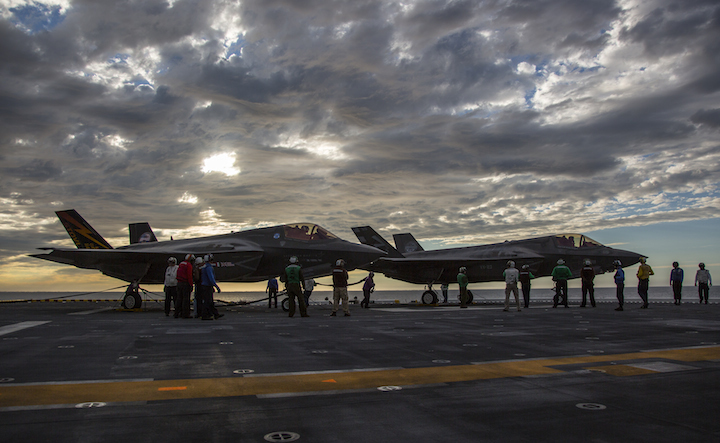
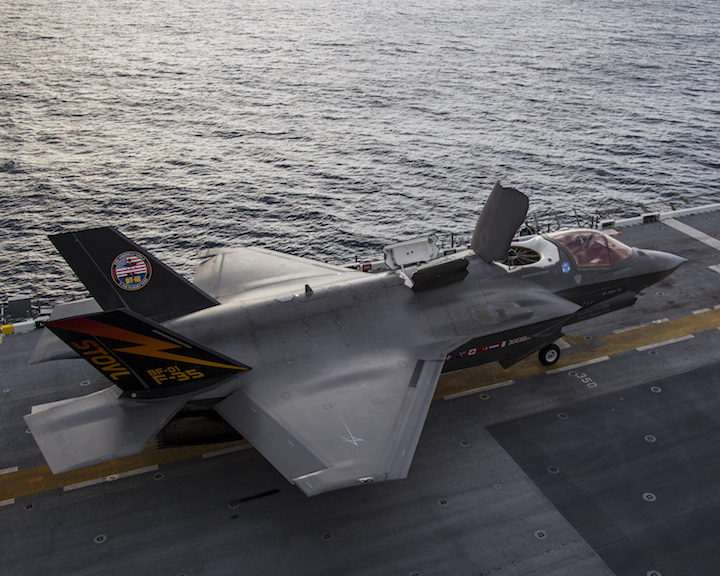
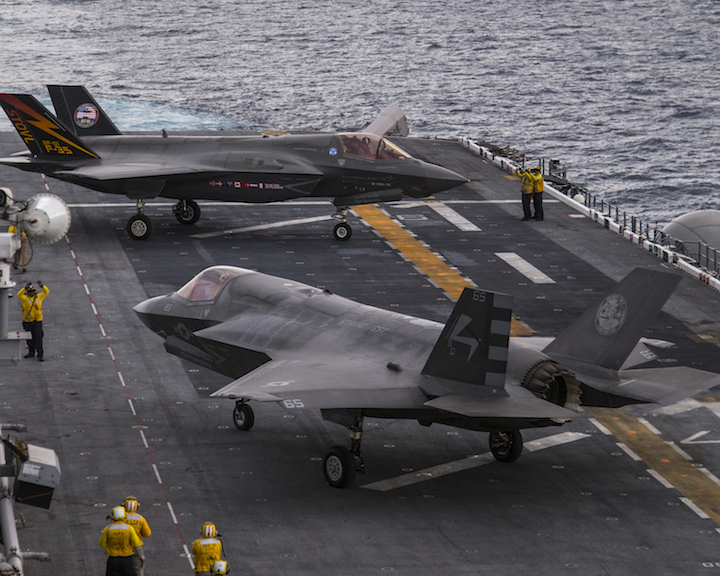

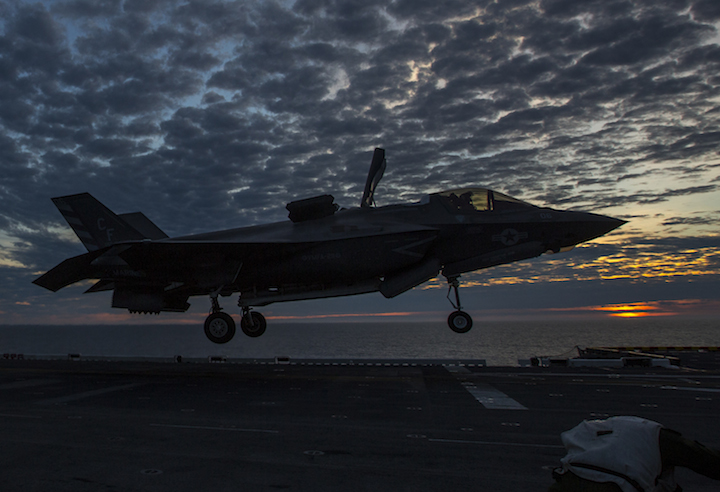
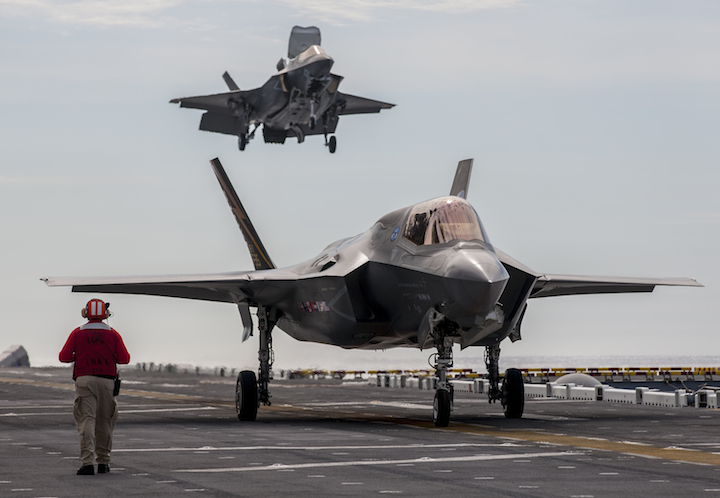
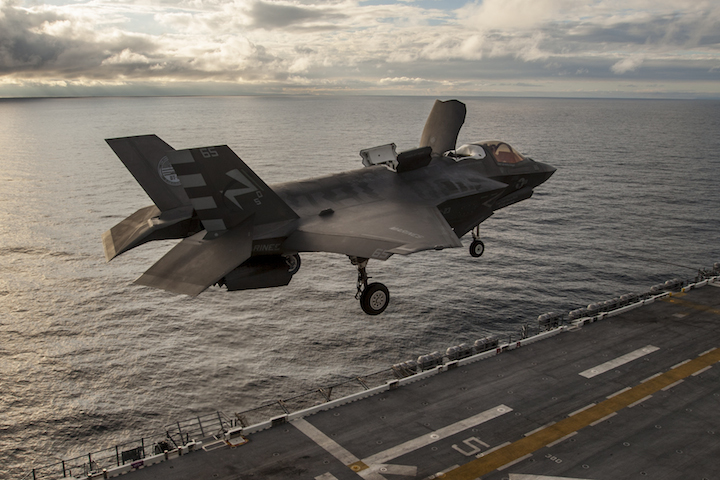
Quelle: Lockheed Martin
-
Update: 14.11.2016
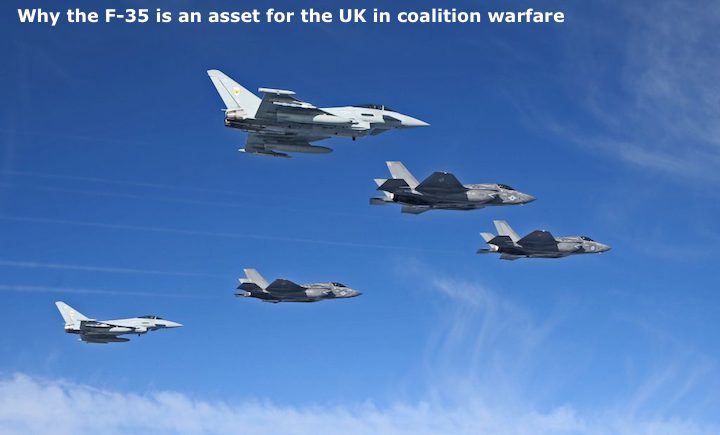
In 2018, the UK’s first F-35 squadron will declare initial operational capability.
It’s no secret that British forces wouldn’t have been able to reach that goal without their partnership with the US Marine Corps.
In order to train to meet operational requirements, a decision was made many years ago to integrate the training of the USMC and RAF together. About 10 years ago the UK’s Royal Air Force and Royal Navy began discussions about combining efforts on initial F-35B training with the United States Marine Corps.
Air Commodore Harv Smyth, UK Lightning Force Commander said:
“It started out as just a conversation about, ‘Wouldn’t it be a good idea to pool our resources?
In the early years, we knew we’d both have a small number of jets and a small number of people training, so it just made sense to work together.”
These discussions eventually resulted in a ‘pooling implementation agreement’ between the RAF, Royal Navy and USMC.
The Royal Air Force and Royal Navy plan to operate 138 F-35B aircraft. Their training will take place at MCAS Beaufort, South Carolina, where British pilots and maintainers will be embedded with the US Marine Corps and their fleet of F-35Bs.
This joint approach to getting the aircraft ready was very clear with recent F-35 trials aboard the USS Wasp, with much of the data produced being used to inform not only the USMC’s declaration of initial operating capability but also the British effort.
UK personnel were fully embedded in the USS Wasp trials and will use the data gathered from this event, future trials and operational deployments to support the UK’s flying trials aboard HMS Queen Elizabeth in 2018.
Co-operation doesn’t just extend to training, plans for frequent deployment of American F-35 aircraft alongside British jets aboard HMS Queen Elizabeth have been confirmed by British Defence Secretary Michael Fallon and are expected to significantly boost the capabilities of the UK’s new carriers.
A key element of 21st century air power is clearly working and smoothly implemented coalition operations, the F-35 provides a unique integrated air combat capability whereby coalitions of joint or allied F-35s can be supported in common. The F-35 was designed from the outset to bring these capabilities while also being interoperable across a coalition of air power.
Two networks are core to this operability: the Link-16 and the new Multi-Function Advanced Datalink (MADL). These systems allow the F-35 to communicate with nearly all current and future NATO assets.
Link-16 is currently utilised by most existing platforms fielded by NATO members and will allow F-35 to integrate seamlessly into a coalition force structure.
MADL will complement the current networks as NATO’s first high bandwidth, low probability of detect and intercept connection. The fundamental design features of MADL enable all NATO F-35s in a deployed coalition to communicate within an Anti-Access/Area Denial environment.
The potential for cooperation between the United Kingdom and coalition forces all using the F-35 variants is significant, in terms of coalition warfare the F-35 further increases the situational awareness of all parties to a greater extent than anything flying today, resulting in a quantum leap in capability for coalition forces.
Such is the aircrafts sensor and data fusion capabilities, a small number of F-35s could provide the UK and her coalition allies with situational awareness within defended airspace where platforms such as E-3 AWACS and E-8 JSTARS would be unable to operate.
F-35s could find and designate priority targets within defended airspace for a less stealthy fleet to attack from a relatively safe distance, further enhancing coalition capability.
The F-35s value is not only in its stealth or combat capability, it’s also in the flying sensor network it creates in the battle space.
The ability of the F-35 to drastically improve the combat capability of other assets was demonstrated recently when an F-35B and Aegis Weapon System worked together during a live fire exercise, with the F-35 passing sensor data to another platform which then engaged the target.
Using the F-35 as a broad area sensor can significantly increase a warships ability to detect, track and engage a target.
An unmodified US Marine Corps F-35B from the Marine Operational Test and Evaluation Squadron, based in Edwards Air Force Base, acted as an elevated sensor to detect an over-the-horizon threat.
The aircraft then sent data through its Multi-Function Advanced Data Link to a ground station connected to USS Desert Ship, a land-based launch facility designed to simulate a ship at sea.
Using the latest Aegis Weapon System Baseline 9.C1 and a Standard Missile 6, the system successfully detected and engaged the target.
The exercise was the first live fire missile event that successfully demonstrated the integration of the F-35 to support Naval Integrated Fire Control-Counter Air and represent a very promising exploration into the interoperability of the F-35B with other naval assets.
The F-35B will drastically increase the situational awareness of the forces with which it will deploy and for the UK, where deployed numbers may be a concern, it represents a fantastic way to enhance combat capability in any coalition or national effort.
Quelle: UK Defence
